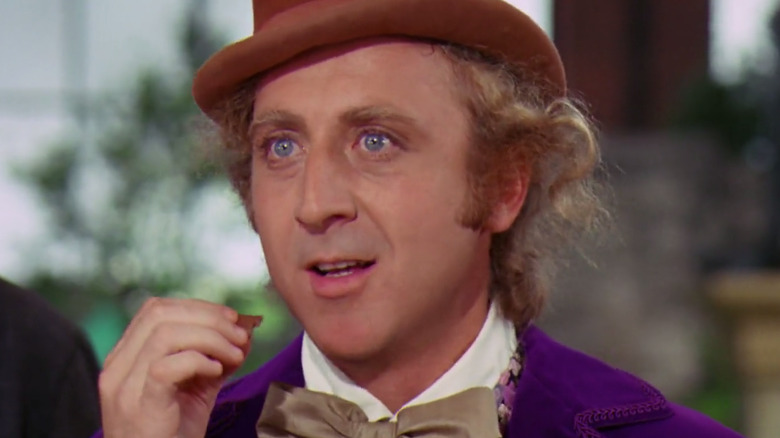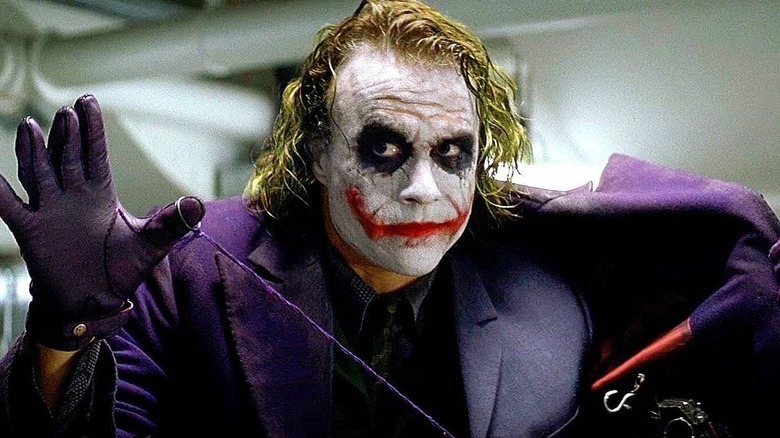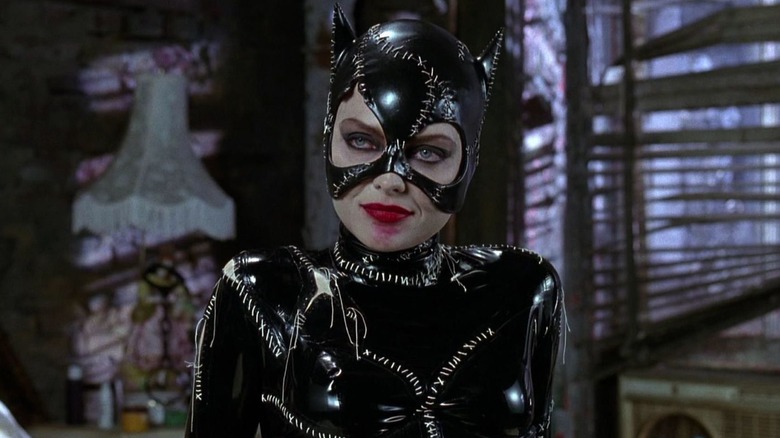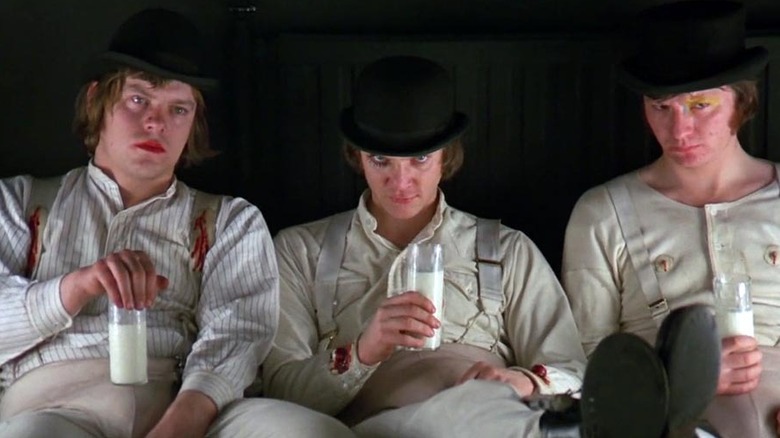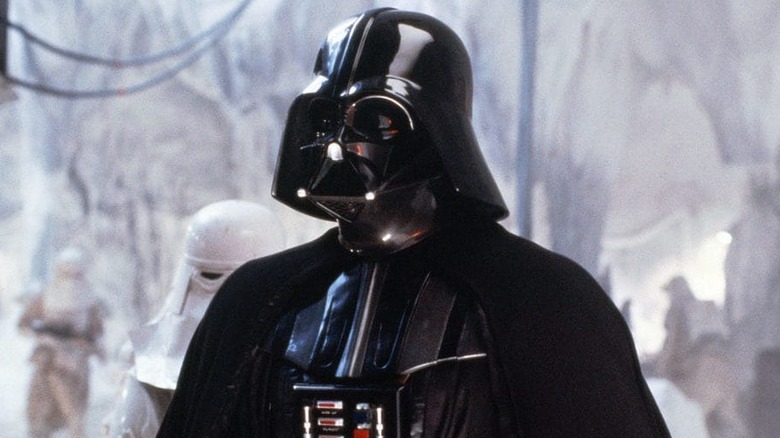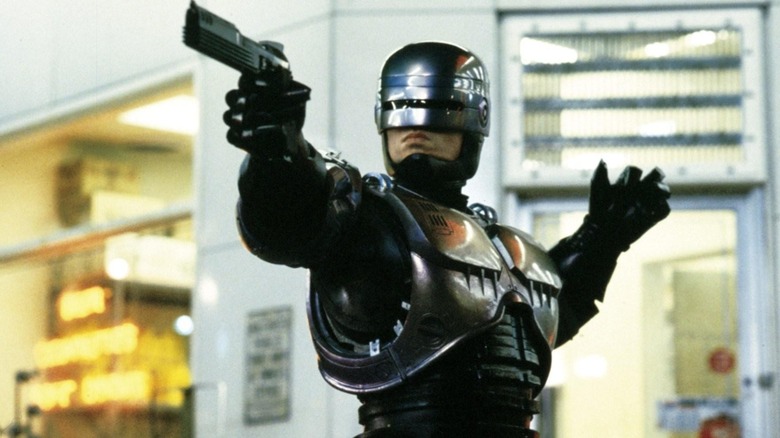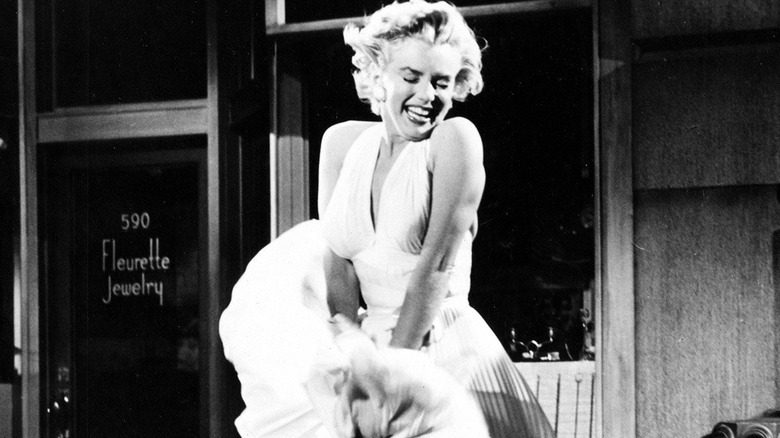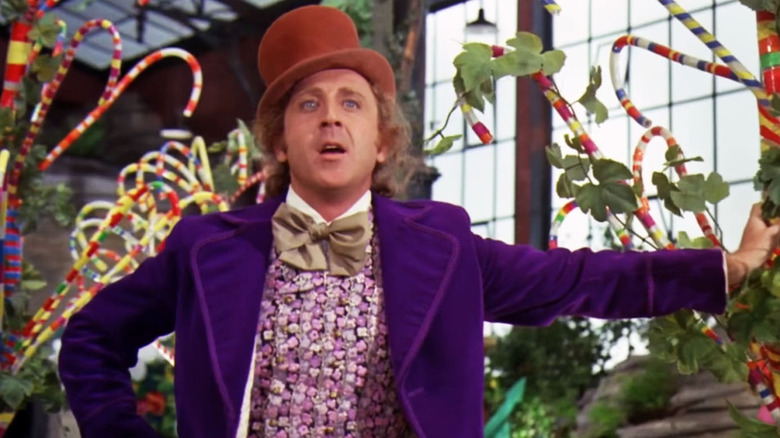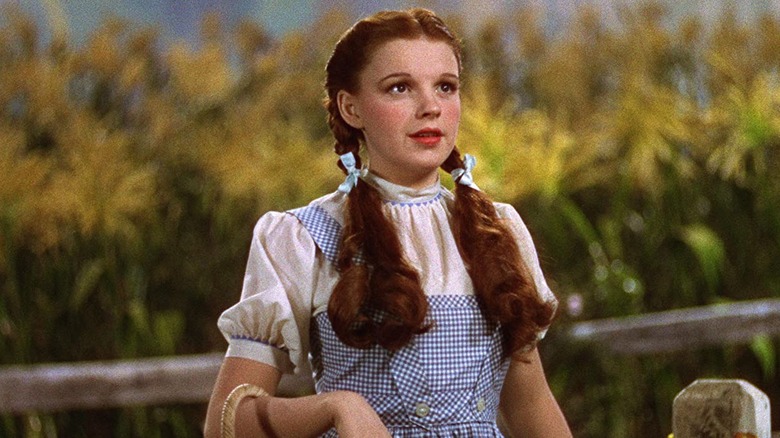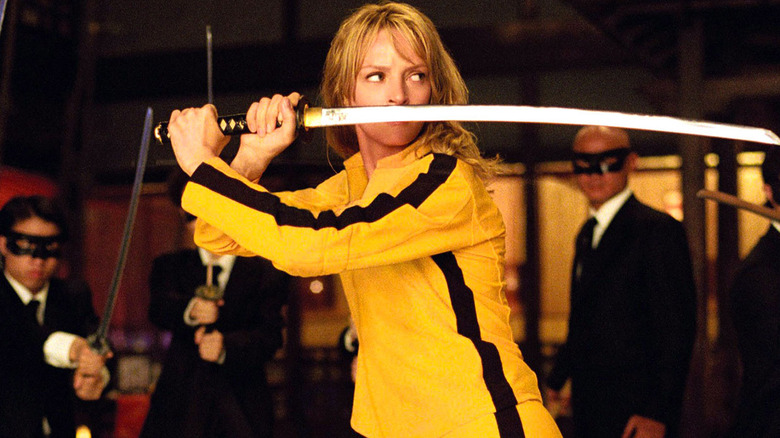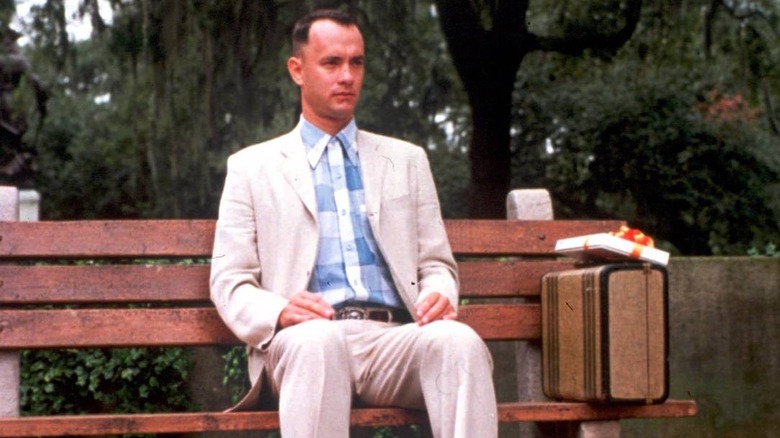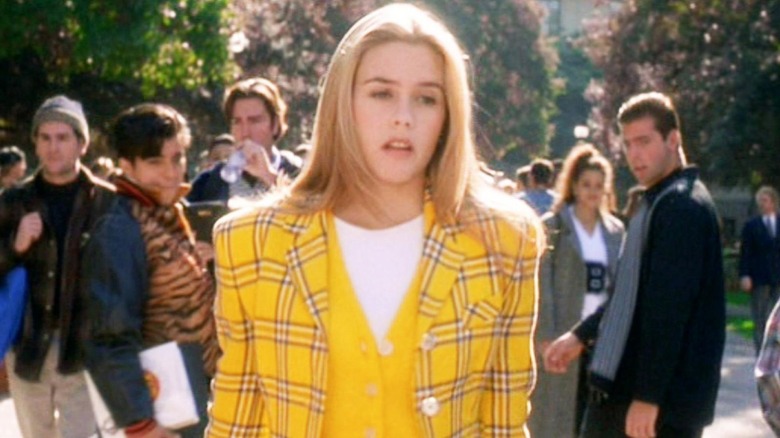The Most Iconic Movie Costumes Of All Time
The job of the costume designer is one of the most important for any movie. Every costume reveals information about the character who wears it, and the right costume for a character tells a story about that person that regular dialogue could not. Most of the time, the costume designer's work is nearly invisible — the clothes fit the story but are ordinary enough that they fade into the background. But sometimes, if the movie is popular enough and the design is eye-catching enough, a costume becomes famous in its own right, as recognizable and iconic as the character it covers. And some may influence the world outside of the movie, spawning imitators and homages from designer fashion labels to children's Halloween costumes.
These are some of the most famous costumes in film history, costumes that have come to be associated with movies, actors, fashion trends, and even entire decades. They range from far-off sci-fi concepts to clothes that could be found in anyone's closet, but each one is a memorable summation of the person wearing it.
Joker suit, The Dark Knight
Jack Nicholson's 1989 portrayal of the Joker in Tim Burton's "Batman" was seen as the definitive cinematic version of the character for years, and so was his outfit, a flamboyant purple suit that could only belong to a clown. Christopher Nolan and Heath Ledger had a lot to live up to when they created a new Joker for "The Dark Knight," and not only did Ledger's performance become the new gold standard for the character, his costume has become the Joker's defining style.
The Nolan Joker's wardrobe isn't as drastic a reinvention as Ledger's performance, but it still creates a more real-world Joker while staying true to the character's theatricality. The suit is still purple, and a deeper shade of purple than one would expect to see out in the open. But far from Nicholson's spotless wardrobe, this suit is faded and dirty, befitting the Ledger Joker's place as a low-level criminal. It's the suit of a natural entertainer capable of brutal violence. Since the 2008 release of "The Dark Knight," it has been the source of many Halloween costumes and influenced the subsequent takes on the character. As different as the Joaquin Phoenix Joker is from Ledger's, his gaudy but unsophisticated suit couldn't exist without the Ledger suit to take inspiration from.
Catsuit, Batman Returns
While Tim Burton's conception of the Joker might have been overshadowed by Nolan's in the pop culture landscape, his version of Catwoman in 1992's "Batman Returns" remains the one to beat to this day, and the accompanying catsuit is still praised as one of the best supervillain designs of all time. Even Nolan knew he couldn't top it and didn't try, giving his Catwoman in "The Dark Knight Rises" a more traditional catsuit that didn't capture the public's imagination in nearly the same way.
Catwoman's suit is iconic for the same reasons it and the rest of "Batman Returns" were controversial in 1992. At a time when superhero movies were generally thought to be for kids, the skin-tight latex suit, accentuated by Michelle Pfeiffer's cherry-red lipstick, was too aggressively sexual for parents. And the coarse stitching that runs throughout the suit is reminiscent more of Burton's tortured Edward Scissorhands than any other blockbuster villain of the time, fueling complaints that "Returns" was just too dark (per Entertainment Weekly).
But the darkness and sexuality are why the catsuit has remained so memorable over the years, because it has no precedent before or after. The 2004 Halle Berry "Catwoman" film tried to make the suit even more sexual, but without the dark edge it was laughed off as cheesy and soon forgotten. The '92 catsuit still retains its power to make the viewer uncomfortable, and for that reason it's stuck in people's minds.
Droogs outfit, A Clockwork Orange
The films of Stanley Kubrick are full of legendary costumes, from the space suits of "2001: A Space Odyssey" to Jack Torrance's red jacket in "The Shining." But only one Kubrick costume could appear in the background of "Space Jam: A New Legacy" with the expectation that the audience knows what it is, and that's the outfit of the Droogs in "A Clockwork Orange." The Droogs' plain white clothes are a signal in any context that chaotic times are ahead.
"A Clockwork Orange" is about a future England ravaged by violence, and the Droogs are dressed perfectly for this scary time and place. At first glance, their wardrobe could make them pass for English gentlemen — they're dressed in spotless white dress shirts and pants with black bowler hats on their heads. But the tan codpieces serving as their belts reveal that something is wrong with them, and hint at their fondness for sexual violence. It's a surprisingly simple design for a movie about an out-of-control future, but that simplicity also makes it stick out more in the turmoil. The viewer looks at the well-dressed young men in this terrible future and assumes that they'll be the connections to our more civilized time. But instead they reveal the barbarism that hides behind polite dress, now and later.
Darth Vader's suit, Star Wars
Darth Vader is the most widely-known movie villain of all time, and we don't even see his face for most of the first "Star Wars" trilogy. In the absence of that, his voice and especially his costume are what define him, creating a vision of evil absent of any kind of physical humanity.
The Vader suit sticks out so much because the costumes of the original "Star Wars" are otherwise as low-tech as possible. The simple white and brown fabrics worn by Luke, Leia, and Obi-Wan could belong to an actual age "a long time ago." But Darth Vader could only be part of a technologically-advanced future, where the distance between man and machine has disappeared. His black cape is a classic symbol of movie villainy, but the other costume elements make him a more modern kind of beast. The control panel on his chest reveals that his human frame is under computerized control, and his mask looks like a skull altered to look as inhuman as possible. It makes the reveal of him being Luke's father even more shocking, a jarring reminder that there still exists a man beneath all this gadgetry.
RoboCop's armor, RoboCop
Like Darth Vader, the tale of RoboCop is a horror story of machines taking over the human body. But Vader is a terrifying monster because the machine elements so seamlessly combine with the body, while RoboCop is more a tragic figure, like Frankenstein's monster, because there's no subtlety to his design. There's both comedy and sadness in this clumsy approximation of the human form with cyborg parts, showing that technology is no substitute for the human body.
Actor Peter Weller had a difficult time trying to move in the RoboCop suit, and it's easy to see why. The suit looks to be overloaded with heavy scrap metal and junkyard parts, making traditional human movement impossible. It's inefficient, sacrificing the grace of the human body for more firepower. The result is a killing machine who lumbers like a toddler, and despite the weapons on hand, it almost makes him clumsily endearing. One has some inherent sympathy when seeing a person struggle to move, and RoboCop's one remaining flesh-and-blood characteristic, the mouth left uncovered by his helmet, reminds the viewer that deep down he is still a person.
Billowing dress, The Seven Year Itch
Sometimes a costume isn't quite iconic on its own and needs another element to push it over the edge. Marilyn Monroe's white dress in "The Seven Year Itch" would not be so instantly recognizable if not for the sewer vent that sends it billowing in the breeze. With the vent, the dress becomes part of one of the most frequently parodied images in film history, one that remains the lasting legacy of the woman wearing the dress.
As a movie, "The Seven Year Itch" isn't remembered as well as other Monroe movies like "Some Like it Hot" or "Gentlemen Prefer Blondes." But the billowing dress is still the most famous film image of Monroe, summing up her appeal as a playful sex symbol. The dress's plunging neckline shows that Monroe's character is aware of her own sex appeal, but the comedy of the image is that she's genuinely taken off-guard by the breeze exposing her legs. She doesn't always go out of her way to look sexy — sometimes she just absentmindedly stumbles into it. More is known now about this "ditzy bombshell" persona being an act, an act concealing the real-world struggles that eventually led to Monroe's death. But to many, she's still just the silly girl struggling to keep her dress down.
Black evening dress, Breakfast at Tiffany's
Audrey Hepburn was the style icon of the '50s and '60s, in no small part thanks to her collaboration with dressmaker Hubert de Givenchy on the costumes for her most famous movies. But even in a field of gorgeous outfits, Hepburn and Givenchy's crowning achievement is the black evening dress worn by Holly Golightly in the opening scene of "Breakfast at Tiffany's," which cemented both Hepburn and Givenchy's reputations as the pinnacles of glamour and cool.
The popularity of the dress at the time and since is partly because, rather than the lavish dresses favored by movies of the time, it's a look attainable by the women watching the movie. The little black dress was already a staple of women's wardrobes, beloved for its practicality and simplicity while still being stylish, and only grew in popularity after the release of "Breakfast." Women of any class or background could look like Holly Golightly with what was already available to them. But what's kept the dress famous throughout the years are the accessories that only someone as synonymous with high fashion as Hepburn could pull off. Not many women have a pearl choker or a foot long cigarette holder at home, because no one could make them look as chic as Hepburn.
Willy Wonka's outfit, Willy Wonka and the Chocolate Factory
Ever since the release of "Willy Wonka and the Chocolate Factory" in 1971, this question has been fiercely debated: is Willy Wonka a magical figure or a dangerous eccentric? Gene Wilder's performance as Wonka makes both answers equally likely, and so does his outfit, which is just as likely to symbolize both wondrous adventure and imminent danger.
Willy Wonka does not dress like a normal human. The top hat, frilly bowtie, and cane make him look like an old-fashioned aristocrat, putting him at a greater power than his much more simply-dressed guests at the chocolate factory. But no aristocrat would dress in such vibrant colors, in purples that glisten like a candy wrapper. His shiny, whimsical appearance seems calculated to provide something for everyone, dazzling children and presenting an air of authority to their parents. It gives no real sense of the man behind the clothes, it seems to be an act to keep people following him even as he keeps leading children to horrible fates. The famous scene in which Wonka cracks and yells at Charlie is notable for being one of the few times he's dressed down, shedding the top hat and jacket and revealing the viciousness underneath the colorful exterior.
Farm dress, The Wizard of Oz
Dorothy in "The Wizard of Oz" often gets reduced to her pair of ruby slippers. But the slippers don't have the same impact without the juxtaposition of the rest of her outfit, which serves as a constant reminder of the home she wishes to return to.
When watching a fantasy world as outrageous as Oz, the viewer needs a strong anchor to reality to keep it from just being ridiculous. Dorothy is that anchor, and her simple farm-girl dress is the only thing that passes for realism once Dorothy lands in Oz. But while it's a realistic outfit, it's not a boring one. Despite what the sepia-toned opening presents, it explodes into Technicolor baby blues along with everything else once the Oz section begins. It keeps Dorothy interesting to look at even as there are more outlandish costumes surrounding her, and it associates her Kansas home with a color other than dusty brown, making it seem like not such a bad place to return to by the end.
Yellow jumpsuit, Kill Bill Vol. 1
An iconic costume in one decade can inspire another iconic costume a few decades later. Quentin Tarantino has made a career of borrowing elements from movies of the '60s and '70s to create new iconic images in the present. In "Kill Bill Vol. 1," he gives lead character The Bride a recreation of the yellow jumpsuit that first belonged to Bruce Lee in his final movie, "Game of Death," passing the baton from one beloved action star to another.
Outside of the Lee homage, the blinding yellow of the jumpsuit is an off-kilter costuming decision for a violent revenge movie. Uma Thurman was hesitant to wear it, complaining that it made her look like a "banana Popsicle." But its unconventionality is what makes it such an effective choice — it's impossible to forget once seen, because no action hero since Lee has even tried to pull it off. The color also makes the streaks of blood that get on it as The Bride starts killing people harder to ignore. The blood might fade into a darker-colored outfit, but it stands in sharp contrast to the bright yellow and is clearly visible as the effect of The Bride's killing force.
Tan suit, Forrest Gump
Forrest Gump sitting at the park bench is one of the most famous movie images in recent decades, and it's not just Tom Hanks' performance that accomplishes that. It's Gump's plain tan suit, which creates an instantly noticeable visual contrast between Gump and the bench. It also creates a contrast between Gump and everybody he meets on his travels, a singular outfit for a singular man.
The image of a sharply-dressed man waiting for a bus, a place where not many people would care about dressing their best, immediately marks Gump as something different than the average person. On closer inspection, the dirty sneakers that go with the clean suit, a confusing combination of formal and informal, raise more questions about Gump. But as he tells his story, his wardrobe makes sense as a representation of a one-of-a-kind figure. The tan suit is especially important to this, an outfit of such simplicity that it belongs to no style or era in particular. This makes it the perfect look for Gump, who passes through every decade and major cultural event of the mid-to-late 20th century without being changed or affected by any of it. He's a man who exists outside of time, wearing clothes that conform to no known code of fashion.
Yellow plaid suit, Clueless
Cher Horowitz in "Clueless" has come to represent the spirit of the '90s teenager in popular culture, speaking in distinctive slang and being obsessed with finding the right outfit. Her wardrobe has been particularly influential, with this plaid suit even copied by high-fashion icon Donatella Versace in her 2018 collection. It's easy to see why Cher's wardrobe is still sought-after more than 25 years after the release of "Clueless" – she can make even the potentially dull uniformity of a school outfit into something unique and stylish.
The sunny California of "Clueless" may stand in stark contrast with the brooding Seattle grunge scene, but the aesthetics of grunge came to be so dominant in the '90s that they found their way into Cher's wardrobe. The plaid favored by Seattle rockers shows up in the pattern on Cher's school uniform, and there are safety pins, one of the key accessories of hard rock going back to the '70s, lining her skirt. But far from the dark red-and-black flannel of Nirvana and Pearl Jam, Cher's outfit is all sunshine yellow, reflecting her own overwhelming positivity and the bright Beverly Hills settings she inhabits. Cher is both part of her time and a trailblazer, taking the trends of the day and bending them to her own cheery sensibility.
